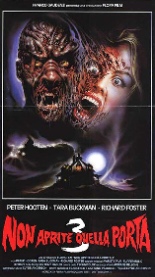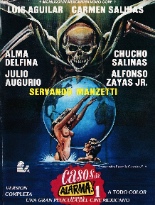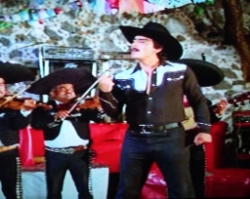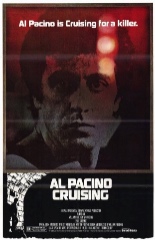
 Ladies of Virginia Beach are all atwitter over an unnamed serial rapist/killer terrorizing the community. (Let’s call him Night Killer, since the movie is named just that.) Luckily, he’s easy to spot: He’s the guy in the Toxic Avenger-esque rubber mask with matching rubber hand spouting spiky yellow fingernails long enough to vie for a Guinness World Record. Only if he stood under a neon arrow flashing “GET MURDERED HERE” could he be more identifiable.
Ladies of Virginia Beach are all atwitter over an unnamed serial rapist/killer terrorizing the community. (Let’s call him Night Killer, since the movie is named just that.) Luckily, he’s easy to spot: He’s the guy in the Toxic Avenger-esque rubber mask with matching rubber hand spouting spiky yellow fingernails long enough to vie for a Guinness World Record. Only if he stood under a neon arrow flashing “GET MURDERED HERE” could he be more identifiable.
His signature move? Punching clean through women’s torsos. Melanie Beck (Tara Buckman, Silent Night, Deadly Night) somehow makes it through a terrifying home-invasion encounter with him, emerging with scraps, bruises and amnesia, but nary an extra hole. After being discharged from the hospital, life for Melanie continues to be a living nightmare, thanks to Night Killer still at large, as well as being stalked — and then abducted and sexually assaulted — by a creepy guy named Axel (Peter Hooten, who donned the cape as 1978’s Dr. Strange).
 As a director, Claudio Fragasso (aka Clyde Anderson) is remarkably consistent. However, as other Fragasso films like Beyond Darkness, Monster Dog, Troll 2, et al. raise their right hands and testify, that consistency is a remarkable disdain for reality and rationale — and Night Killer might be his most imbecilic. Nothing happens as it should or would, even when allowing for a moviegoers’ suspension of disbelief. For example — and this is minor, mind you — Melanie reacts to a threatening phone call by looking in the mirror and yanking out her breasts. In fact, it’s just the first of several instances that call for Buckman to bare at least one of them, which accounts for her wardrobe choice of saggy sweaters for easy access; exposure happens so often — perhaps only a single instance merited — that I felt embarrassed for her.
As a director, Claudio Fragasso (aka Clyde Anderson) is remarkably consistent. However, as other Fragasso films like Beyond Darkness, Monster Dog, Troll 2, et al. raise their right hands and testify, that consistency is a remarkable disdain for reality and rationale — and Night Killer might be his most imbecilic. Nothing happens as it should or would, even when allowing for a moviegoers’ suspension of disbelief. For example — and this is minor, mind you — Melanie reacts to a threatening phone call by looking in the mirror and yanking out her breasts. In fact, it’s just the first of several instances that call for Buckman to bare at least one of them, which accounts for her wardrobe choice of saggy sweaters for easy access; exposure happens so often — perhaps only a single instance merited — that I felt embarrassed for her.
Elsewhere, Melanie lays out a picnic of pills on the shore. In a public bathroom, Axel is forced at gunpoint to strip to the blue banana hammock that passes for his underwear. Seemingly from another movie emerges Blind Vision’s Lee Lively as an apparent stand-in for Donald Pleasence’s signature Halloween role of Dr. Loomis. I’m more than happy to discuss the bonkers twist, but don’t get me started on the choreographer. —Rod Lott


 Only in the 1970s — or at least the New World Pictures version of the 1970s — could you make absolute heroes out of a pair of cop-shooting, hostage-banging, dynamite-toting bank robbers the way that the drive-in favorite
Only in the 1970s — or at least the New World Pictures version of the 1970s — could you make absolute heroes out of a pair of cop-shooting, hostage-banging, dynamite-toting bank robbers the way that the drive-in favorite 





 In 2072, the TV networks’ biggest shows are reality competitions like Killbike and The Danger Game, both as nihilistic as they sound. (Isn’t that crazy? I don’t mean those shows, but the idea that TV networks will exist in 2072. Oh, that
In 2072, the TV networks’ biggest shows are reality competitions like Killbike and The Danger Game, both as nihilistic as they sound. (Isn’t that crazy? I don’t mean those shows, but the idea that TV networks will exist in 2072. Oh, that 

 Undoubtedly one of the most controversial films ever made, William Friedkin’s provocative tale of a homosexual killer on the loose in the sultry sexual playground of New York City in the 1980s is constantly being re-evaluated and reinterpreted through far more educated eyes than mine, but time has aged it well enough for me to at least admit that it’s an incomprehensible serial-killer flick that you just can’t look away from.
Undoubtedly one of the most controversial films ever made, William Friedkin’s provocative tale of a homosexual killer on the loose in the sultry sexual playground of New York City in the 1980s is constantly being re-evaluated and reinterpreted through far more educated eyes than mine, but time has aged it well enough for me to at least admit that it’s an incomprehensible serial-killer flick that you just can’t look away from.